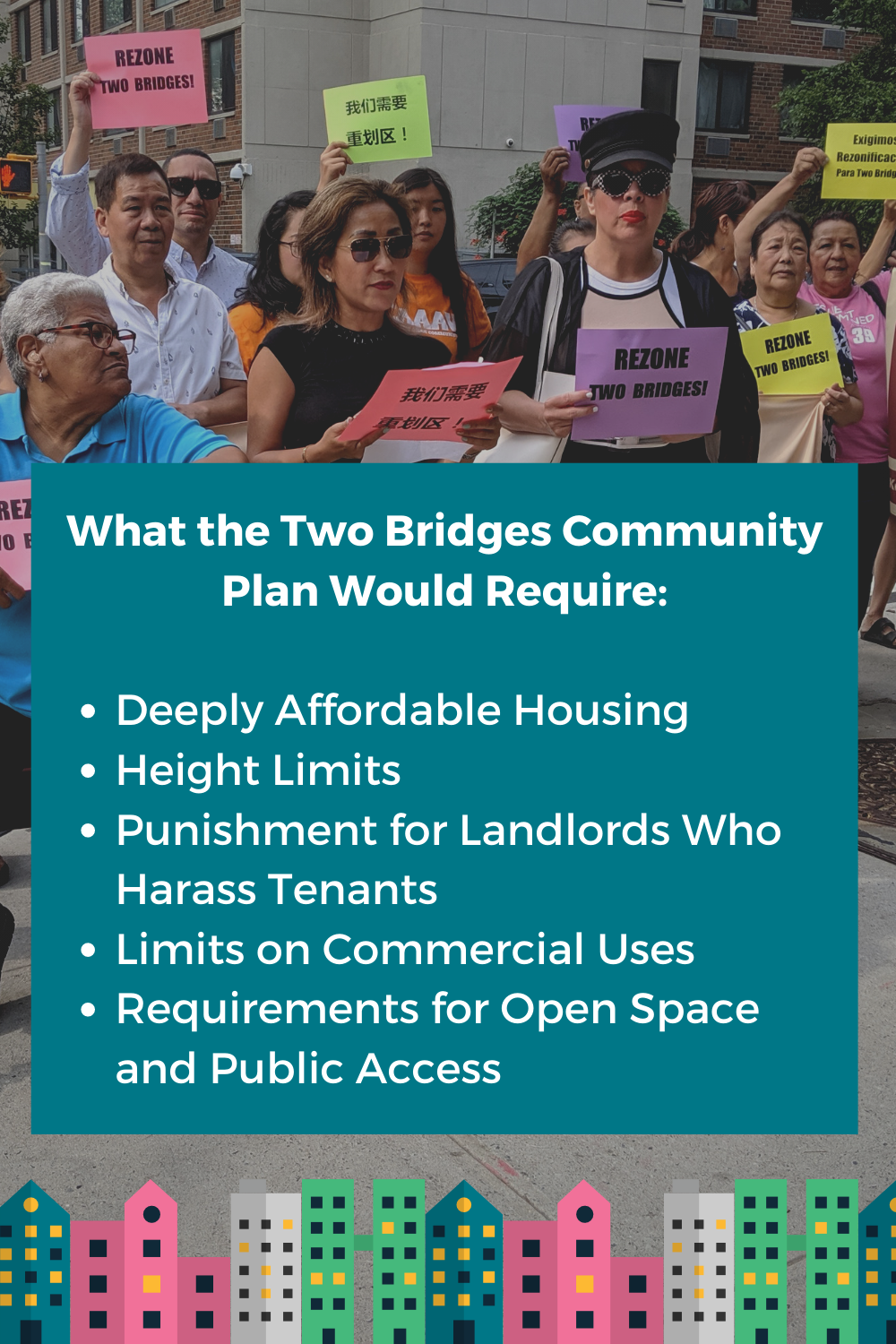Community Groups Have Submitted Their Own Rezoning Application for Two Bridges as the First Step Towards Enacting the Larger Chinatown Working Group Plan
At the end of February, Judge Engoron of the New York State Supreme Court gave back-to-back rulings nullifying the City Planning Commission’s approval of four super-tall luxury towers proposed in Manhattan’s Two Bridges neighborhood. These rulings – on suits brought by a variety of local groups including CAAAV, GOLES and TUFF-LES – came after the judge already found approval should not have been granted in a suit brought by the City Council. For those keeping score, that’s three separate rulings making clear these towers should never have been approved in the first place.
These lawsuits are real victories for the community and an important first step in ensuring any future development truly serves existing residents. But lawsuits are a short-term solution – given the underlying zoning and the fact that the City has clearly indicated their approval, there’s no guarantee developers won’t try to build towers like these again. To make sure that can’t happen, there’s only one long-term solution: pass the Two Bridges Community Plan.

The Two Bridges Community Plan is one portion of the larger Chinatown Working Group Plan (CWG) and is the first step towards getting the full CWG Plan enacted. The Chinatown Working Group Plan came out of a five-year community planning process involving over 50 civic, community, and cultural organizations as well as Community Boards 1, 2, and 3. The plan came together following the 2008 East Village / Lower Side Rezoning – a rezoning that left out Chinatown and Two Bridges – over fears that it would increase development pressure in these neighborhoods, leading to residential and commercial displacement. The plan included a host of recommendations on affordable housing, economic development, and cultural and historic preservation as well as detailed zoning proposals for different subdistricts of the neighborhoods, including Two Bridges.
But despite all the cross-neighborhood work that went into it, the CWG Plan was rejected by the de Blasio administration in 2015 under then Department of City Planning Director Carl Weisbrod, with the claim that it was too large for the City to move forward. While the City said no to the CWG Plan, development plans like Extell’s as-of-right One Manhattan Square and then the proposed Two Bridges Towers moved forward, despite the fact that these proposals from private developers were directly at odds with the community’s vision.
The CWG Plan for the Two Bridges neighborhood (Subdistrict D) seeks to “promote mixed-use development that produces new affordable housing,” but to do so in a fashion that serves this historically diverse, low- and moderate-income community. The plan involves imposing height limits of 350 feet, requiring 50% affordable housing at income levels that match the neighborhood, and limiting certain uses like hotels, big-box stores and nightclubs. The four proposed towers directly contradict this vision with heights from over 600 to 1,000 feet and 25% affordable housing through the use of a lucrative tax abatement program that allows folks to pay $12 a month in real estate taxes on their $1.4 million condos.

It’s the CWG’s vision for Subdistrict D that local groups are moving forward as the Two Bridges Community Plan. Given the imminent threat these towers pose to the Two Bridges neighborhood, residents and community groups decided they couldn’t afford to wait: if the City was unwilling to act on the CWG Plan, they would begin to initiate the process themselves. Local groups TUFF-LES, CAAAV, and GOLES – in partnership with Community Board 3 – put in their own rezoning application for the Two Bridges Community Plan, making sure any future development in that subdistrict would have to match the CWG Plan’s call for height limits, affordability requirements, and use restrictions.
There is no time to wait. The Two Bridges Community Plan has been submitted to the City and the work is ongoing to move it forward. But this is just the first step to getting the larger CWG plan enacted. With neighborhoods from Bushwick to Inwood to Southern Boulevard pushing back on the City’s proposed rezoning plans while their own community generated plans are being ignored, the limitations of the City’s approach to rezonings are becoming clear. A new way forward is needed, one that centers planning under an equity framework and works with communities as good faith partners. Revisiting the Chinatown Working Group Plan and the vision its numerous stakeholders put forward is the right place to start. Passing the Two Bridges Community Plan is the first step to making that happen.